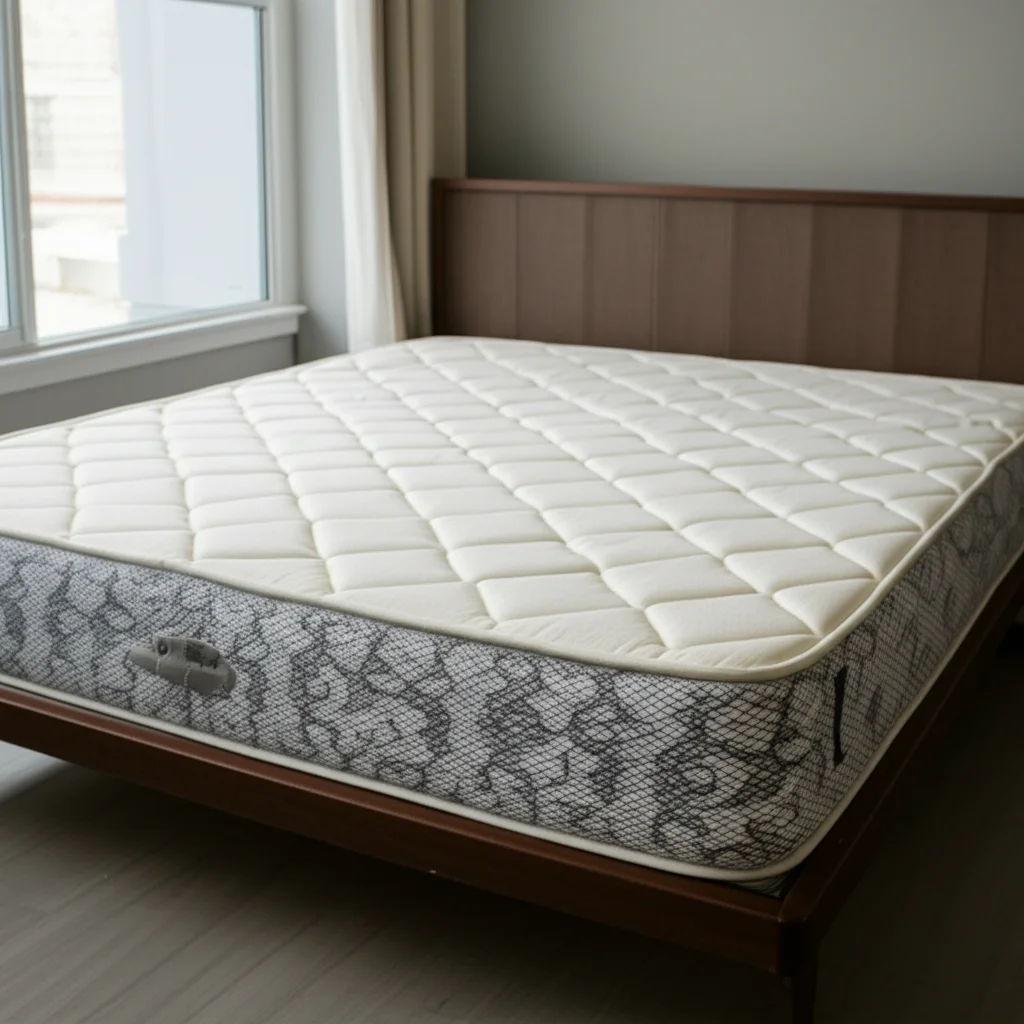· Todd Martin · Home Organization · 19 min read
How To Store Latex Mattress

How To Store Latex Mattress Safely and Smartly
Do you need to store your latex mattress for a while? Maybe you are moving, renovating, or simply need extra space. Knowing how to store a latex mattress properly is important. These mattresses are valuable investments, known for their comfort and durability. Incorrect storage can lead to damage, mold, or unpleasant odors. I will guide you through the correct steps to ensure your mattress remains in excellent condition. This article covers preparation, proper packaging, choosing the right storage environment, and avoiding common mistakes. We will explore everything you need to know for successful latex mattress storage.
Takeaway
- Clean and dry your latex mattress thoroughly before storage.
- Protect the mattress from moisture, dust, and pests using suitable covers.
- Store your latex mattress flat in a climate-controlled environment.
- Avoid folding or bending the mattress to prevent permanent damage.
- Inspect and air out the mattress periodically during long-term storage.
Storing a latex mattress properly involves cleaning, thorough drying, and wrapping it in breathable, protective plastic or a mattress bag. Place it flat in a cool, dry, dark, climate-controlled space, away from extreme temperatures and humidity, to maintain its integrity and prevent damage or mold growth.
Preparing Your Latex Mattress for Storage
Proper preparation is the first step when you store your latex mattress. This stage sets the foundation for its long-term health. Skipping preparation steps can lead to problems like mold, mildew, or unpleasant smells. Start by stripping all bedding from the mattress. Then, ensure the mattress surface is clean and completely dry.
Cleaning Your Latex Mattress
Cleaning your latex mattress before storage removes dirt, dust, and allergens. This step prevents these elements from becoming embedded during storage. Use a vacuum cleaner with an upholstery attachment to remove surface debris. Focus on seams and crevices where dust gathers. If there are any spills or stains, spot clean them immediately. You can make a mild cleaning solution. Mix a small amount of gentle soap with water. Lightly dampen a cloth with this solution and gently blot the stain. Do not saturate the mattress. Latex is highly absorbent and excessive moisture can cause damage. For general cleaning tips, consider looking into how to deep clean your mattress.
Addressing Stains and Odors
Lingering stains or odors can worsen during storage. If you have liquid spills, blot them up quickly. For urine or other organic stains, a mixture of baking soda and water can help. Apply the paste, let it dry, then vacuum it away. This helps neutralize odors. For stronger smells, sprinkle baking soda directly on the mattress. Let it sit for several hours, or even a full day. Then, vacuum it thoroughly. This natural deodorizer helps absorb lingering odors. If you are dealing with particularly stubborn stains, understanding how to clean stains from a mattress can provide more detailed methods.
Ensuring Complete Dryness
This is arguably the most important step for latex mattress storage. Any moisture remaining in the mattress can lead to mold and mildew growth. Mold can destroy latex and pose health risks. After cleaning, allow the mattress to air dry completely. Place it in a well-ventilated room, possibly near a fan. You can also place it near a window on a sunny day. Ensure both sides of the mattress are dry. It may take 24 to 48 hours for complete drying. Do not rush this process. Feel the mattress all over to check for any damp spots. A moisture meter can confirm dryness if you are uncertain. If you discover mold, learning how to clean mold off mattress is essential before storage.
Proper Packaging for Latex Mattress Storage
Once your latex mattress is clean and dry, packaging it correctly is vital. The right packaging protects it from environmental factors. These factors include dust, dirt, pests, and moisture. Incorrect wrapping can damage the mattress or trap moisture inside.
Choosing the Right Mattress Bag
You need a strong, breathable mattress bag for latex storage. Standard plastic mattress bags are common for moving. However, ensure they are thick enough to resist tears. Look for bags specifically designed for long-term storage. Some bags have ventilation holes or are made from breathable materials. These types prevent moisture from accumulating inside. Avoid cheap, thin plastic that can tear easily or trap humidity. The bag should be large enough to fully encase the mattress without compressing it. Choosing the right protector is similar to considering how to put on a mattress protector for daily use, but for storage, breathability is key.
Wrapping and Sealing the Mattress
Carefully slide the mattress into the chosen bag. Ensure the bag covers the entire mattress surface. For extra protection, you can add a layer of soft, absorbent material inside. A cotton sheet or mattress pad can absorb any residual humidity. Once the mattress is inside, seal the bag tightly. Use strong packing tape to close all openings. Make sure there are no gaps for dust or pests to enter. Do not use airtight plastic if the bag is not specifically designed for mattress storage with proper ventilation. While a vacuum seal might seem good for space, it can damage latex foam. Latex needs to breathe to maintain its elasticity and prevent off-gassing issues.
Protecting Against Pests and Dust
The mattress bag acts as your primary defense. However, consider adding a secondary layer for long-term storage. A sturdy moving blanket or furniture wrap can offer extra physical protection. This additional layer guards against accidental punctures or abrasions. Pests like rodents and insects are attracted to undisturbed areas. Ensure your storage area is free from pest activity. Place natural repellents, like cedar blocks, near the mattress if permitted. Never place repellents directly on the mattress surface. The mattress should be elevated off the ground. Using pallets or wood blocks prevents direct contact with cold or potentially damp concrete floors. This elevation also deters crawling insects.
Ideal Environment for Storing Latex Mattresses
The storage environment is just as crucial as the preparation and packaging. Latex mattresses are sensitive to extreme conditions. Proper climate control is key to preserving their integrity. An unsuitable environment can lead to irreversible damage.
Climate-Controlled Storage Units
A climate-controlled storage unit is the best option for latex mattresses. These units maintain a consistent temperature and humidity level. This consistency prevents the latex from degrading. Extreme heat can cause latex to break down. High humidity encourages mold and mildew growth. Low humidity can make the latex brittle over time. Look for units that stay between 60-75°F (15-24°C) with humidity levels between 40-50%. This range is ideal for preserving the material. Investing in climate-controlled storage protects your investment. It also saves you from replacing a damaged mattress later.
Avoiding Extreme Temperatures and Humidity
Garages, attics, and basements are often poor choices for storing a latex mattress. These spaces typically experience wide temperature fluctuations. They also tend to have high humidity. Garages and attics can become very hot in summer and very cold in winter. Basements are often damp and prone to flooding. These conditions create a breeding ground for mold and mildew. They also accelerate the breakdown of latex foam. If you must use a garage, for example, consider tips on how to store a mattress in the garage but always prioritize climate control for latex. Even if you insulate, it might not be enough. Always prioritize a stable environment.
Ensuring Proper Ventilation
Even in a climate-controlled unit, good airflow matters. Do not stack items directly on top of or tightly around your latex mattress. Leave some space around the mattress for air circulation. This helps prevent stagnant air. Stagnant air can contribute to musty odors. Placing the mattress on elevated pallets or skids is important. This lifts it off the floor. It allows air to circulate underneath. It also protects against any potential ground moisture. Good ventilation helps the mattress “breathe.” This maintains its freshness over long periods.
The Right Position: Storing Latex Mattresses Flat
The way you position your latex mattress during storage significantly affects its lifespan. Unlike some other mattress types, latex requires a specific orientation. This helps maintain its shape and structural integrity.
Why Flat Storage is Essential
Latex foam is incredibly resilient but also sensitive to prolonged pressure in specific areas. Storing a latex mattress on its side or on an end can cause permanent damage. The weight of the mattress will press down on the edges. This leads to indentations, sagging, and structural breakdown over time. The foam can compress and lose its bounce. This damage is often irreversible. A damaged mattress will not provide the same comfort or support when you retrieve it. Always plan for flat storage space. This might mean clearing out more room than you expect.
Avoiding Folding or Bending
Never fold or bend a latex mattress. Some mattress types, like memory foam, can be rolled or compressed for shipping. Latex mattresses cannot. Folding or bending will cause irreversible creases and cracks in the foam. The cellular structure of latex is designed to be flexible but not to fold. Even slight bending can weaken the material. This leads to lumps and unevenness. If you need to move a latex mattress, carry it flat. Use proper moving techniques to prevent bending. For instance, slide it onto a flat trolley or use multiple people to lift it.
Supporting the Mattress Evenly
When storing flat, ensure the surface underneath is completely flat and supportive. Do not store it on an uneven floor. Do not place it on top of other items that create bumps. A flat wooden pallet or a clean, level floor is ideal. This ensures the mattress’s weight is distributed evenly across its entire surface. Even distribution prevents any single area from bearing too much pressure. If you are stacking items, place the latex mattress on top of the stack. Make sure the support beneath it is firm and level. Avoid placing heavy objects on top of the stored mattress. This can also cause compression and damage over time.
Long-Term vs. Short-Term Latex Mattress Storage
The duration of storage influences the level of care and preparation. While general principles apply, specific considerations arise for long-term storage. Short-term storage allows for a bit more leniency.
Short-Term Storage (Less Than 3 Months)
For short-term storage, the preparation steps are still important. Cleaning and drying remain crucial to prevent immediate issues. However, the exact climate control might be slightly less critical. If you are storing it for a few weeks, a garage or basement might suffice if it is reasonably dry and stable. Ensure the mattress is well-wrapped in a breathable bag. Keep it elevated off the floor. The primary goal for short-term storage is protection from dust, dirt, and accidental spills. You do not need to worry as much about long-term material degradation. Still, try to keep it flat. Avoid stacking anything heavy on top. This maintains its shape even for a brief period.
Long-Term Storage (Over 3 Months)
Long-term storage demands strict adherence to all guidelines. Climate control becomes non-negotiable. Consistent temperature and humidity protect the latex from drying out or becoming moldy. Regular checks are also beneficial. If you visit your storage unit, briefly inspect the mattress. Check for any signs of dampness, odors, or pest activity. You might even unseal a small part of the bag to air it out for an hour. Re-seal it tightly afterwards. This periodic airing helps prevent musty smells. It also allows you to catch any problems early. For example, if you detect a strange odor, it might indicate moisture or pest issues. Addressing these quickly can save your mattress. This proactive approach ensures your latex mattress remains pristine for years.
Periodic Checks and Maintenance
Even in ideal conditions, a latex mattress stored long-term benefits from occasional checks. Every few months, open the storage unit. Inspect the mattress bag for any tears or damage. Look for signs of condensation inside the bag. If you find condensation, there might be a humidity issue in the storage unit. You may need to address the climate control. Check the mattress surface for any visible mold spots or unusual odors. If any issues are detected, promptly address them. Re-dry the mattress if it feels damp. Re-wrap it with a fresh bag if the old one is compromised. These checks prevent small problems from becoming irreversible damage.
Common Mistakes to Avoid When Storing Latex Mattresses
Storing a latex mattress can seem simple, but specific pitfalls can lead to permanent damage. Being aware of these common mistakes helps ensure your mattress survives storage in top shape. Avoiding them saves you money and preserves comfort.
Don’t Fold or Roll the Mattress
This is the most critical rule for latex mattresses. Unlike some other foam types, latex is not designed to be folded or rolled tightly. Attempting to do so will cause the foam to crack or tear. It creates permanent creases and divots. The internal structure of the latex will break down. This destroys the mattress’s supportive properties and comfort. Always transport and store your latex mattress flat. If space is an issue, consider a different type of mattress for storage that can be rolled, or invest in a larger storage unit.
Avoid Plastic That Isn’t Breathable
While you need to protect the mattress from moisture, dust, and pests, using non-breathable, airtight plastic can be detrimental. This type of plastic can trap residual moisture inside the bag. This creates a humid environment, which is perfect for mold and mildew growth. It also prevents the latex from off-gassing. Latex can have a distinct smell, and trapping this smell can make it worse. Use a mattress bag specifically designed for storage. Look for ones made from breathable materials or with small ventilation holes. This allows for air circulation while still protecting the mattress.
Never Store Vertically on Its Side
Storing a latex mattress on its side, even for a short period, can cause irreversible damage. The mattress’s weight will press down on the edge. This leads to compression and permanent indentations. It can also cause the internal structure of the latex to deform. This results in an uneven sleeping surface when you retrieve it. Always store your latex mattress flat on a stable, level surface. This distributes its weight evenly and prevents any single point from bearing undue stress.
Do Not Store in Extreme Temperatures or Humidity
Garages, attics, and non-climate-controlled basements are hostile environments for latex. High temperatures accelerate the breakdown of the latex material. This causes it to become brittle or crumbly. High humidity promotes mold and mildew. Low humidity can dry out the latex, making it less resilient. Freezing temperatures can also damage the foam structure. Invest in a climate-controlled storage unit. This ensures stable conditions. This is the single best way to protect your latex mattress from environmental damage.
Forgetting to Clean and Dry Thoroughly
Any moisture left in the mattress before storage will lead to mold. Dust and dirt can become embedded. These issues can ruin your mattress and create health hazards. Always vacuum, spot clean any stains, and allow the mattress to air dry completely for at least 24-48 hours. Use fans or sunlight to aid the drying process. This step is non-negotiable for preserving your mattress.
Moving Your Latex Mattress to Storage
Moving a latex mattress requires careful planning and execution. Latex can be heavy and floppy, making it challenging to transport. Proper handling prevents damage to the mattress and injury to yourself.
Get Help for Lifting and Carrying
Latex mattresses, especially larger sizes, are surprisingly heavy. They can also be quite flexible, making them difficult to maneuver alone. Always enlist the help of at least one other person. Two or more people can lift and carry the mattress flat. This distributes the weight and prevents bending or folding. Using proper lifting techniques is important. Bend your knees, keep your back straight, and lift with your legs. Avoid twisting your body while carrying the mattress. Safety is paramount for both you and the mattress.
Use a Mattress Bag for Transport
Even for short moves, a sturdy mattress bag is essential. This protects the mattress from dirt, dust, and scuffs during transport. It also makes the mattress easier to grip and carry. If you are moving it through doorways, the bag can prevent snags. Ensure the bag is thick and tear-resistant. Seal it well to keep debris out. This protective layer is the first line of defense against damage during transit. It’s similar to how you would protect mattress when moving any other type of mattress.
Transport Flat Whenever Possible
The ideal way to transport a latex mattress is flat. Use a large truck or trailer where it can lie horizontally. This prevents any stress on the foam structure. If flat transport is not possible due to vehicle size, the mattress can sometimes be gently bent into a large “U” shape for a very short distance. However, this is risky and should be avoided if possible. Never fold it completely in half. If you must bend it, ensure the bend is gentle and wide. Do not tie it down so tightly that it creates sharp creases. Use straps that are wide and flat to distribute pressure.
Secure the Mattress During Transit
Once loaded, secure the mattress to prevent shifting. Use moving straps or ropes to tie it down. Ensure the straps are taut but not overly tight. Over-tightening can compress the foam and cause damage. Place furniture blankets or padding between the straps and the mattress. This prevents the straps from digging into the material. If transporting in an open truck, cover the mattress with an additional tarp. This protects it from rain, road grime, and sun exposure. The goal is to keep it stable, protected, and in its flat shape during the entire journey.
Retrieving Your Latex Mattress from Storage
After a period in storage, retrieving your latex mattress requires careful steps. You want to ensure it is fresh, clean, and ready for use. Proper retrieval prevents bringing any storage issues into your home.
Unpacking the Mattress Safely
Once you bring the mattress to its destination, carefully remove the outer layers of packaging. Use scissors or a box cutter cautiously. Cut along the seams of the mattress bag. Be very careful not to cut into the mattress itself. Once the bag is open, gently slide the mattress out. If you used a secondary blanket, remove that as well. Observe the mattress as you unpack it. Look for any signs of mold, mildew, or damage that might have occurred during storage.
Airing Out the Mattress
After being sealed for a long time, your latex mattress may have a slight “stored” smell. This is normal. It is also important to let it breathe. Place the mattress in a well-ventilated room. Open windows and use fans to encourage airflow. If possible, expose it to indirect sunlight for a few hours. Direct, intense sunlight can degrade latex, so be cautious. Allow it to air out for at least 24 to 48 hours before putting on bedding. This process helps dissipate any lingering odors and refreshes the material.
Inspecting for Damage or Pests
Before placing it on your bed frame, give the mattress a thorough inspection. Check all sides and seams for any visible signs of damage. Look for tears, indentations, or changes in the foam’s texture. Run your hand over the surface to feel for any lumps or unevenness. Pay close attention to any discoloration, which could indicate mold or mildew. Also, inspect for signs of pests, such as droppings or chew marks. If you find mold, you will need to clean it thoroughly. If pests are present, treat the mattress before use.
Cleaning and Refreshing After Storage
Even if the mattress looks fine, a quick refresh is a good idea. Vacuum the entire surface again to remove any dust that might have settled. For extra freshness, lightly sprinkle baking soda over the mattress. Let it sit for an hour or two, then vacuum it up. This helps absorb any lingering odors. If you want to take it a step further, consider using a fabric refresher spray designed for mattresses. Always ensure the mattress is completely dry after any cleaning. Once it is clean, fresh, and thoroughly inspected, your latex mattress is ready for use.
FAQ Section
Is it okay to store a latex mattress in a garage?
No, it is not okay to store a latex mattress in a typical garage. Garages often experience extreme temperature swings and high humidity. These conditions can cause latex to degrade, become brittle, or develop mold and mildew. A climate-controlled environment is essential for preserving the mattress.
How long can a latex mattress be stored?
A latex mattress can be stored for several months to a few years. This is possible if you follow all proper storage guidelines. The key is consistent climate control, excellent ventilation, and proper packaging. Regular checks also extend safe storage duration.
Can mold grow on a latex mattress in storage?
Yes, mold can grow on a latex mattress in storage. This happens if there is any moisture present when packaged or if the storage environment is too humid. Ensure the mattress is completely dry before storage and maintain low humidity levels.
Do I need a special bag to store a latex mattress?
Yes, you need a sturdy, breathable mattress bag for storage. Avoid thin plastic sheets or completely airtight bags. Breathable materials prevent moisture buildup. They also protect against dust, dirt, and pests.
Should I store my latex mattress flat or on its side?
You must store your latex mattress flat. Storing it on its side, or folding/bending it, can cause permanent indentations and damage to the foam structure. Always ensure it lies on a flat, even surface to distribute its weight.
What temperature is best for storing a latex mattress?
The best temperature range for storing a latex mattress is between 60-75°F (15-24°C). Aim for a humidity level between 40-50%. Consistent conditions prevent the latex from degrading due to heat or becoming brittle from cold, and inhibit mold growth.
Conclusion
Storing a latex mattress properly ensures its longevity and maintains its comfortable feel. We have explored the critical steps from thorough cleaning and drying to selecting the right breathable packaging. The importance of a climate-controlled environment, with stable temperatures and humidity, cannot be overstated. Remember to always store your latex mattress flat, avoiding any folding or bending that could cause irreversible damage. By following these guidelines, you protect your investment and guarantee your latex mattress will be just as supportive and comfortable when you retrieve it. Take the time to prepare and store your mattress correctly. You will thank yourself later for preserving its quality.
- latex mattress storage
- mattress care
- long-term storage
- mattress preservation
- foam mattress storage
- home storage





